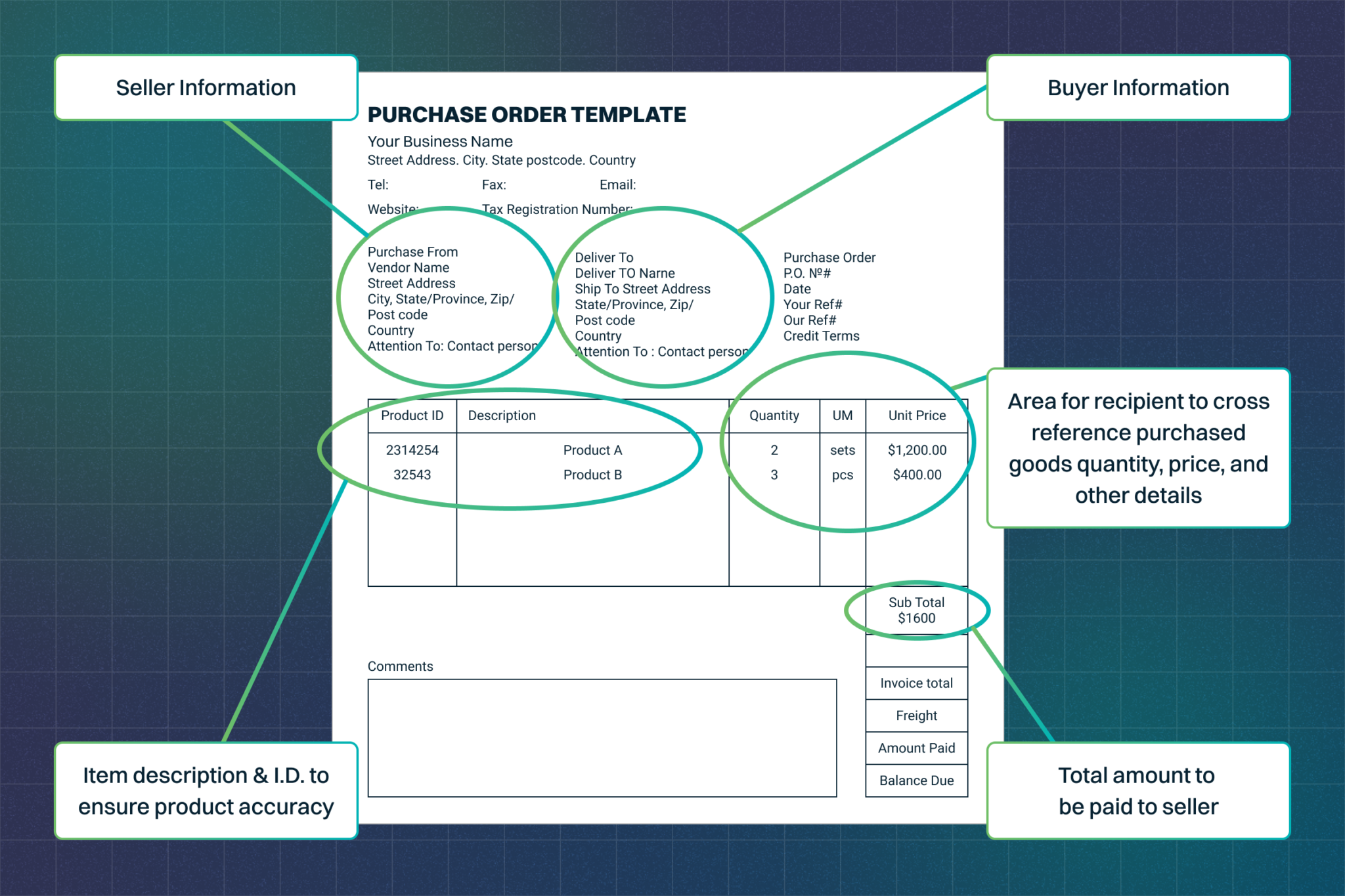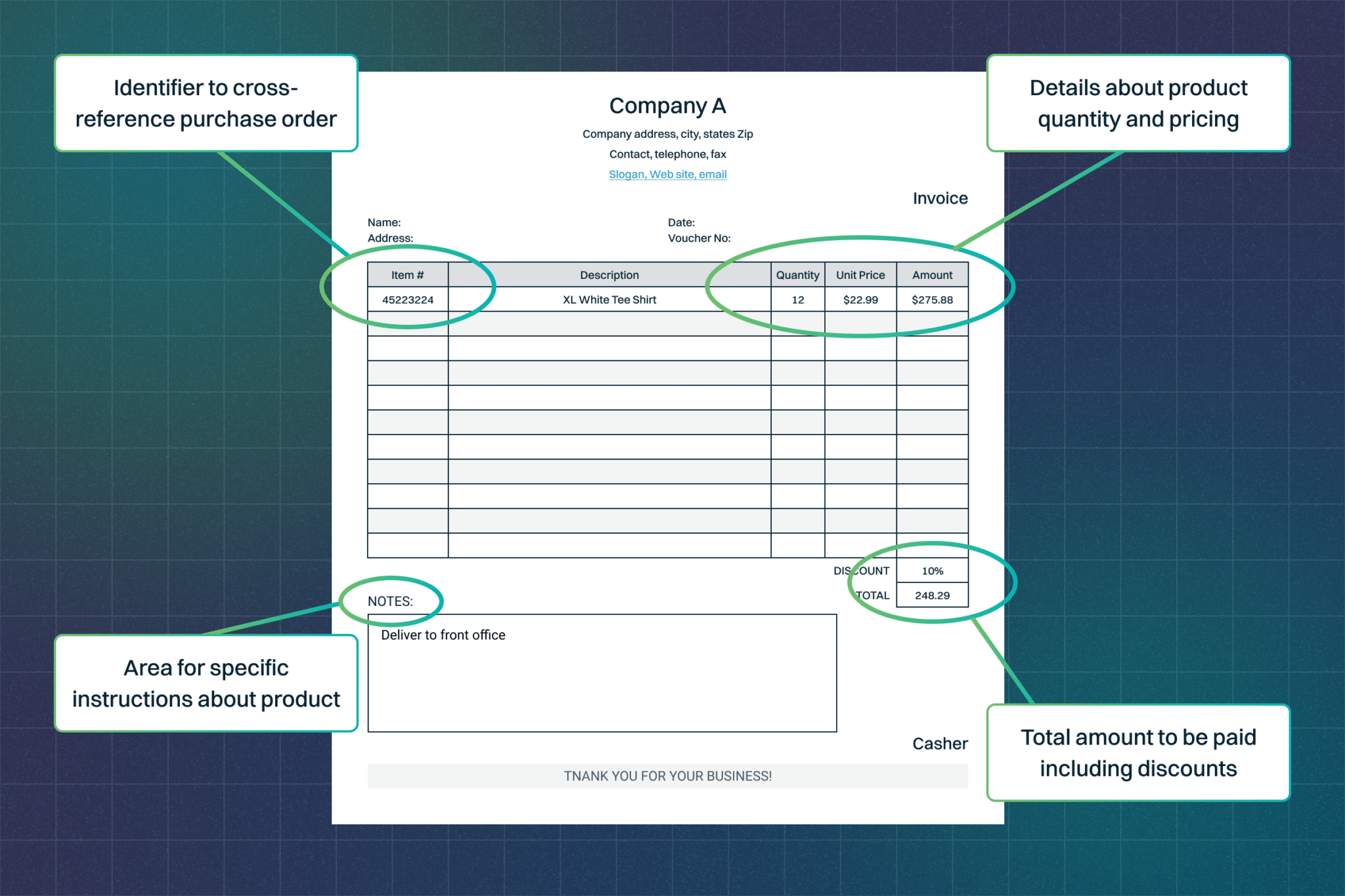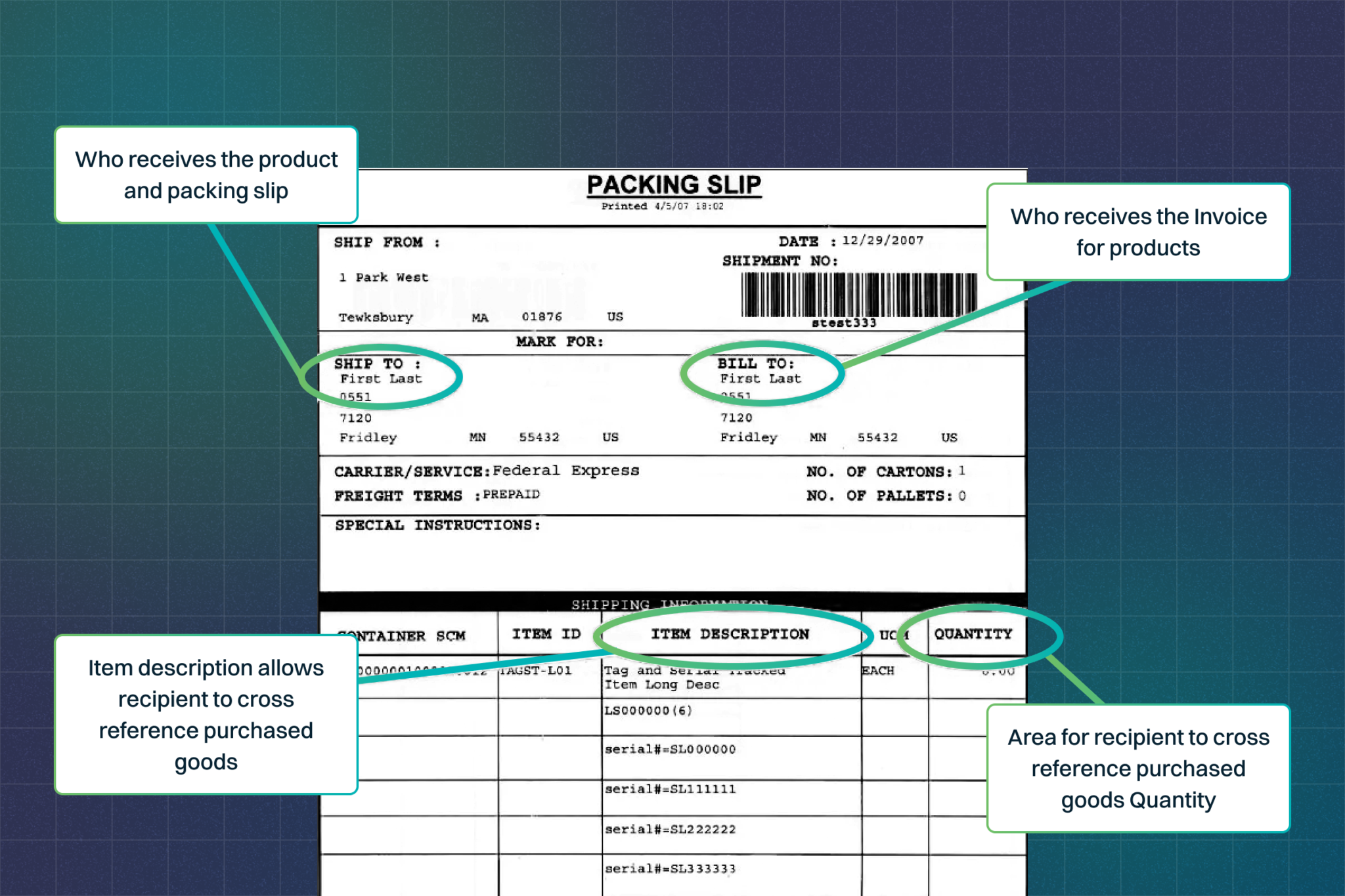Know the difference: Purchase orders (PO), packing slips, and invoices
For retailers and eCommerce sellers, knowing the difference between a purchase order, packing slip, and invoice is critical to efficient operations.
It starts with the purchasing process. After all, you can’t sell what you don’t have!
Between ordering, shipping, and receiving, there is a learning curve that sellers must overcome to be successful. Full disclosure: this is easier said than done.
However, by conducting research and some good old-fashioned trial and error, you can become a pro in no time.
Sellers have to learn how to purchase efficiently and figure out what works for their business. This post should help ease any apprehension you may have about the purchasing process by going over the basics of purchase orders, invoices, and packing slips.
What is a purchase order?
A purchase order (PO) is the order request sent from a buyer to a seller. This document contains details about the type and quantity of items being ordered. It will also outline the purchase prices that have been agreed upon and the payment terms.
Buyers use purchase orders to ensure the products that arrive are indeed the products they ordered. Since the introduction of purchase orders in retail industries, the purchasing process has become more efficient and allows for better inventory and payment tracking.
To submit a purchase order, the buyer typically uses an electronic software system that allows for better tracking and electronic submission to suppliers. Purchase orders provide necessary details sellers and buyers use to keep accurate data on past sales or purchases.
The purchase order includes:
- A PO number
- A shipping date
- Billing address
- Shipping address
- The requested items, quantities, and price
- Terms
Purchase order example:
If you need purchase order templates, here are a few places you can find free templates for purchase orders:
Our inventory management software, SkuVault Core, can automatically generate Purchase Orders based on pre-set replenishment levels and pull vendor contact information directly into purchase order templates. This can save a significant amount of time.
Why is a purchase order important?
Once buyers issue a purchase order and it is accepted by the seller, it becomes the governing document for the sale. The purchase order provides a promise to pay, based on the terms of the agreement from the buyer. This gives sellers the confidence to provide the goods.
As part of an overall sales agreement, it can be a binding contract between the parties mitigating the seller’s risk and providing some legal protections if the buyer defaults. The purchase order number is especially useful for tracking. Sellers can use POs to match shipments with purchases using purchase orders’ numbers. POs also include both the buyer’s and seller’s information to help make it easier for all parties to reconcile.
What is an invoice?
A seller prepares the invoice for the buyer after the buyer submits a purchase order. An invoice is a non-negotiable document. This means that the seller accepts the terms and agrees to provide the goods or services ordered but is not willing to make any changes or negotiate the terms.
Need to start at the beginning? See our guide on how to create an invoice.
While the purchase order is issued by the buyer, the invoice originates with the selling party. It identifies both buyers and sellers and should reference the purchase order. It describes – and quantifies – the items being sold, shows the date of shipment, unit costs and any discounts applied, delivery times, and payment terms. It may also include information about shipping and the mode of transportation.
Invoice example:
If you need invoice templates, here are a few places you can find free templates for invoices:
A free invoice template may work for very small operations that only occasionally have to create invoices.
If you want something more streamlined, you can automatically generate invoices from SkuVault Core that can be part of tracking inventory through the pick, pack, and ship process.
Invoices and POs provide many of the same details. This makes sense because the invoice acts as a bill for the order to request payment.
As such, it is very important that both documents contain the same information so that each party can match up POs and Invoices for accuracy.
What is the difference between a purchase order and invoice?
The primary difference between purchase order and invoice is the purpose of the documents and technical details that are on the PO that are not included on an invoice.
For sellers, an invoice serves as a polite way to ask buyers for the money they owe for the products they have delivered. Invoices are a friendly reminder that the goods delivered have still not been paid for. Like other billing methods, invoices sometimes allow for extensions on payments.
Companies usually only use invoices in B2B transactions. The transaction of goods between businesses is more credible than B2C sales, so sellers are confident they will receive payments when buyers can make them.
As a supplier to retailers or eCommerce businesses, the goods are typically sold at a markup by the buyer. This creates cash flow that gives the original sellers more confidence that they will get paid.
Why is an invoice important?
Invoices are important for sellers as a way to get paid on time. By matching invoices up with purchase orders, it allows for a more seamless transaction. In essence, it closes the loop between the order and the request for payment.
Invoices also provide evidence that the products or services have been delivered. This shows that the seller has lived up to the terms of the agreement and establishes a seller’s right to payment. If the buyer does not pay, it provides additional proof that the seller fulfilled the order.
From an accounting standpoint, an invoice records the transaction as accounts receivable until all debts have been paid.
What is a packing slip?
A packing slip is a shipping document that comes with an order inside the shipping package or tucked inside a shipping pouch attached to the package.
Sometimes referred to as a waybill, packing list, or shipping list – a packing slip itemizes product details so that the receiver can make sure the items in the shipment match what they ordered.
What is the difference between a packing slip and an invoice?
Both invoices and packing slips are sent to buyers from sellers, but they serve completely different purposes. All businesses use invoices, but not all businesses use packing slips.
For example, service-based businesses do not use packing slips for a very obvious reason: they don’t sell products. Instead, they just issue invoices.
Packing slips are only required if there are products being shipped and received for sale.
Another difference between an invoice and a packing slip is who receives the documents.
If you are the one sending these documents, it’s important to keep in mind who should receive them. The invoice should be sent to the person responsible for payment. This might be the accounting department, for example.
The packing slip would be sent to the department that receives the items so they can record the incoming goods. In some cases, this may be the same person but it is more likely different areas of the business, especially in a warehouse or large-scale operation.
In the real world, there have been a lot of problems with startup businesses or in new relationships when packing slips and invoices were sent to the wrong person.
Every shipment should include a packing slip. The details on the packing slips will be customized based on the business and goods being sold.
The document should list the order date, the products included in the order, and the quantity of each product. Depending on the business, the weight of the product may also be included. Details like these are important to many buyers who use the packing slip as a guide when unpacking their order.
Packing slip example
Here is an example of what a typical packing slip would look like and the detail it contains:
If you need packing slip templates, here are a few places you can find free templates for packing slips:
If you are doing a low volume business, these free templates may work for you.
For more robust businesses or warehouse operations, you’ll want to generate packing slips using an inventory management system, such as SkuVault Core, to automate pick lists that can double as packing slips or use packing skips generated by your shipping software.
SkuVault Core integrates with all the popular shipping solutions, including ShipStation, ReadyCloud, ShipRush and ShipWorks.
Why is a packing slip important?
Packing slips are important for a variety of reasons. For sellers, packing slips provide an accurate count of the items being shipped. They can serve as a check during the quality control phase of fulfilling orders to make sure the right items and right amounts are going out the door.
For buyers, packing slips work the same way on their end to make sure the goods received matches what the packing slips say. Catching any discrepancies before they leave the seller’s facility is important. By clearly identifying the contents of the package, the person receiving it can check off the items against the list. The best time for buyers to catch any problems with incoming orders is when they first arrive.
While invoices should be kept by both buyers and sellers for recording, once the goods have been received and checked, packing slips are no longer needed.
Purchase orders vs. packing slip vs. invoice – How they work
Purchase orders, invoices, and packing slips all serve different purposes, but they work together. Both buyers and sellers win when they execute these transactions properly.
The seller makes a profit from the buyer, and, in turn, the buyer makes a profit from their customers, who ultimately purchase the product. Thanks to purchase orders, invoices, and packing slips this process runs smoothly and efficiently.
A real-world example
Let’s take a look at a real-world example of how the entire purchasing process works from start to finish and how these documents work together:
- Purchase order creation: Company A is running low on stock for one of their top-selling products. They need to reorder to keep sales flowing. Company A creates a purchase order with the quantity and specific requirements for the product. This purchase order is delivered to the supplier, Company B.
- Purchase order received: Company B receives the purchase order and confirms they are able to supply the product with the required specifications.
- Order shipped: Company B then ships the products to the buyer and includes a packing slip. They also send an invoice requesting payments for the goods that have been delivered.
- Order received: Company A uses the packing slip to make sure the order is correct and cross-references the purchase order, packing slip, and invoice to make sure they are all in agreement. Once everything is in order, the invoice is processed for payment.
- Order recorded: Having accepted the goods into stock, Company A will enter this information into their inventory management system to keep records accurate.
Company A is a buyer in this scenario, but they may also become a seller. When a consumer subsequently purchases a product from Company A, this company will create their own packing slip to send with the product(s).
Before shipping, Company A will confirm they are shipping the right item(s) by comparing the packing slip to the purchase order. This step alone avoids any possibility of the transaction resulting in a mis-ship.
Company A then ships the customer their product along with a packing slip. Once the customer receives the product, they will then use the packing slip to confirm their purchase.
This entire purchasing process and selling process can be done manually using spreadsheets or Word documents, but it’s prone to error and difficult to track.
Using Linnworks suite of inventory and warehouse management software, you can more reliably manage the entire process from start-to-finish. You can save time by automating processes and assuring accurate inventory counts throughout the entire buying and selling process.
Common questions about purchase orders, packing slips, and invoices
Here are some of the more common questions about purchase orders, packing slips, and invoices.
Are there different types of purchase orders?
Yes. Suppliers will accept standard purchase orders, such as those generated by SkuVault, but there may be times you want to use different POs for specific purposes, such as:
- Contract: Contract purchase orders are for a specified period. You may, for example, have a PO for a supplier that’s good for a year. Details of specific orders and time frames may vary.
- Blanket: Blanket purchase orders are sometimes used to order specific items without a delivery schedule or to establish an “open account” to reorder on a regular or irregular schedule as needed.
- Planned: Planned purchase orders are used when items, quantities, and price are known but delivery dates are unpredictable.
What is the difference between an invoice and a bill?
While people tend to use “invoice” and “bill” interchangeably, they have different meanings.
A bill is a simplified list and generally requests immediate payment – like what you get after eating at a restaurant. An invoice is a more detailed breakdown of the goods or services you’ve ordered and specifies payment terms and obligations.
What is the difference between a sales invoice and a receipt?
An invoice is a request for payment. A receipt is proof that payment has been made.
What is a statement?
An invoice is issued as a request for payment based on specific shipments or delivered goods. A statement is issued as a summary of all outstanding charges as part of the collection process. Typically, invoices are sent when goods are shipped or delivered. Statements are usually sent out monthly as a reminder of all unpaid invoices and account activity.
What is the difference between a packing slip and a bill of lading?
A bill of lading (BOL) is a document that transfers ownership of items from sellers to buyers. A BOL is a legal document that serves as confirmation that a freight shipment was delivered.
A packing slip shows the actual goods being delivered in the shipment.
What is a blanket purchase order?
A blanket purchase order is a type of long-term agreement between a buyer and a supplier, in which the buyer agrees to purchase a certain quantity of products or services from the supplier over a specified period. This type of arrangement can be beneficial for both parties, as it streamlines the procurement process and provides the supplier with a steady, predictable stream of orders.
Conclusion
When running a business or warehouse, it is very important to know the differences and roles that these documents play in the purchasing process.
Purchasing for a business can be a stressful process for some. Learning how to properly place and receive orders can be tricky, especially if you have never done it before. However, it is something that you simply must learn to do properly, and once you get the hang of it, purchasing can be a smooth and seamless process.
Remember these basics and take control of your business.



